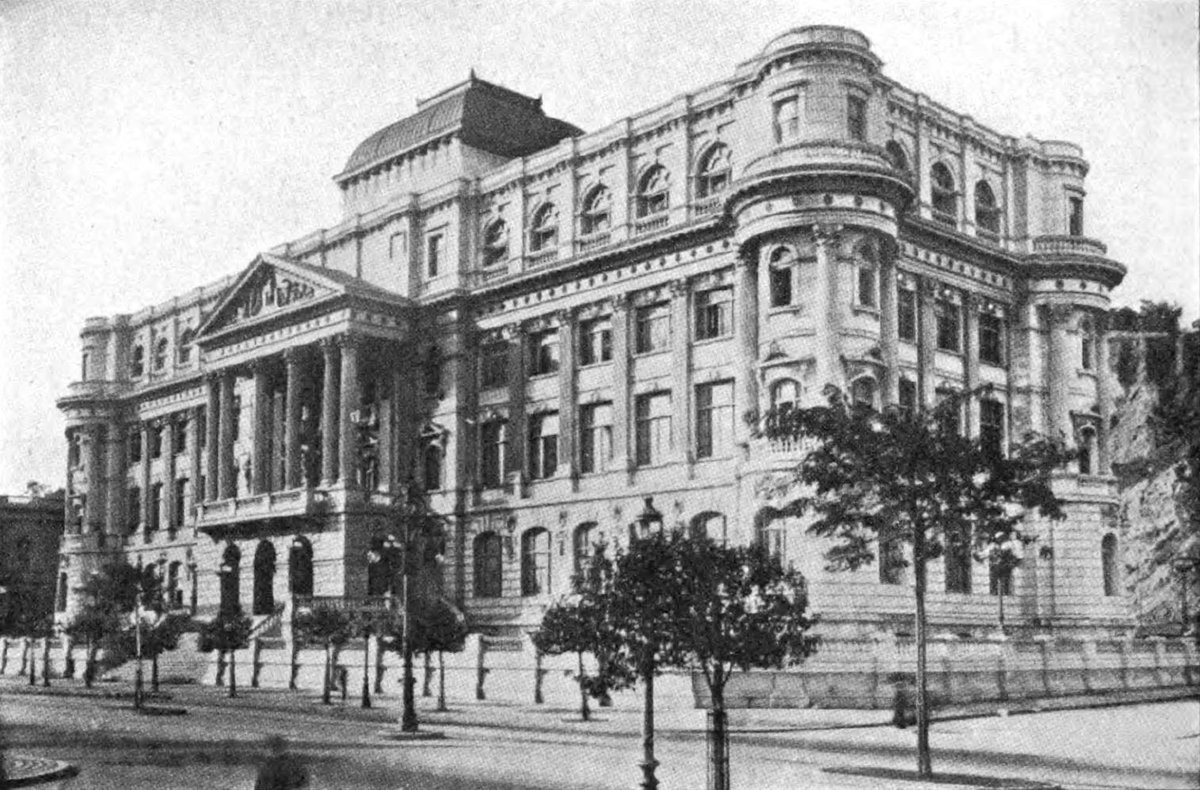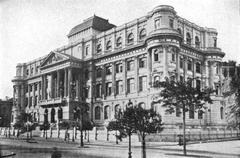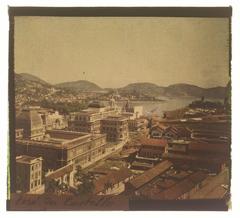
National Library of Brazil: Visiting Hours, Tickets, and Historical Significance in Rio de Janeiro
Date: 14/06/2025
Introduction
Situated in the historic heart of Rio de Janeiro, the National Library of Brazil (Biblioteca Nacional) stands as one of the world’s foremost repositories of knowledge and culture. As the largest library in Latin America and among the top ten globally, it is a living testament to Brazil’s commitment to cultural preservation and intellectual pursuit. The library’s history is deeply rooted in pivotal moments of Portuguese and Brazilian history, while its stunning neoclassical and Art Nouveau architecture marks it as a must-visit Rio de Janeiro historical site. This guide covers everything you need to know about the National Library of Brazil: its origins, architectural highlights, visiting hours, ticketing, accessibility, and nearby attractions, ensuring an enriching experience for every visitor (Wikipedia; Riotur; Atlas Obscura; Factsgem).
Table of Contents
- Introduction
- Origins and Historical Evolution
- Architectural Highlights
- Collections and Cultural Significance
- Visiting Hours and Ticket Information
- Accessibility and Visitor Tips
- Navigating the Library: Layout and Facilities
- Nearby Rio de Janeiro Historical Sites
- Frequently Asked Questions (FAQ)
- Visitor Guidelines and Safety
- Planning Your Visit: Final Recommendations
- References and External Resources
Origins and Historical Evolution
The National Library of Brazil traces its origins to the aftermath of the 1755 Lisbon earthquake, which destroyed much of Portugal’s cultural heritage, including the Royal Library. This tragedy prompted the Portuguese monarchy to prioritize the safeguarding of its collections. When Napoleon’s forces invaded Portugal in 1807, the royal family fled to Brazil, bringing with them what remained of the Royal Library’s treasures.
In 1810, Prince Regent John officially founded the Royal Library in Rio de Janeiro, with the initial collection arriving between 1808 and 1811 (Wikipedia; Atlas Obscura). The library became public in 1814, gradually expanding its access and collections. The 1907 legal deposit law further cemented its role as the national repository, requiring publishers to submit a copy of all printed works.
Architectural Highlights
The library’s current building, inaugurated in 1910, is a masterpiece of eclectic design blending neoclassical symmetry with Art Nouveau details. Designed by Sousa Aguiar, with contributions from artists like Eliseu Visconti, the structure features:
- A monumental façade with grand columns, sculpted reliefs, and balustrades
- A central atrium illuminated by stained glass skylights
- Ornate marble staircases and wrought ironwork
- Richly decorated reading rooms, such as the “Salão de Obras Raras” (Rare Works Hall)
- Artworks and period furnishings celebrating Brazil’s literary heritage
Its location at Avenida Rio Branco, 219, Cinelândia, places it among other historic landmarks, forming a vibrant cultural district (Riotur; Live the World).
Collections and Cultural Significance
With over 9 million items, the National Library’s collections are among the world’s most comprehensive:
- Books and Periodicals: Extensive holdings in multiple languages, covering all fields of knowledge (Factsgem)
- Rare Manuscripts: Colonial and imperial documents, personal papers, and unique early editions
- Maps and Prints: Rare cartographic materials and artistic depictions of Brazil’s evolution
- Photographic Archives: Including the UNESCO-inscribed Teresa Cristina Maria collection
- Music and Audiovisual Materials: Manuscripts, sound recordings, films, and radio broadcasts
- Digital Collections: An expanding platform offering remote access to digitized works
The library also pioneers in library science, preservation, and international collaborations, maintaining active ties with global institutions (Factsgem).
Visiting Hours and Ticket Information
Location: Avenida Rio Branco, 219 – Centro, Rio de Janeiro, RJ, Brazil
Visiting Hours:
- Monday to Friday: 10:00 AM – 5:00 PM
- Closed on weekends and public holidays
- Hours may vary on holidays or for special events; always check the official website for updates
Admission:
Entry is free for all visitors. Some special exhibitions or guided tours may require advance booking or a small fee.
Guided Tours:
Offered in Portuguese, English, and Spanish, typically during weekdays. Advance booking is recommended (Riotur).
Accessibility and Visitor Tips
- Accessibility: The library is wheelchair accessible and has ramps and elevators. Some historic areas may have limited access due to preservation.
- Transportation: Easily reached by public transit; Cinelândia metro station is a five-minute walk away.
- Parking: Limited nearby; public transportation is advised.
- Facilities: Restrooms, free Wi-Fi, a café, and a gift shop are available.
- Photography: Permitted in most public areas without flash; restrictions apply in special collections and exhibitions.
- Security: Present your ID upon entry and be prepared for security checks.
Travel Tips:
- Wear comfortable shoes, as you’ll be walking through spacious interiors and up staircases.
- Allow at least 1–2 hours for your visit to fully appreciate the collections and architecture.
- Learn a few Portuguese phrases or use a translation app, as English proficiency among staff varies (Travellers Worldwide).
Navigating the Library: Layout and Facilities
- General Reading Room: Open to all; ideal for reading and study, with beautiful period decor.
- Rare Books and Manuscripts Room: Restricted access; available for researchers by appointment or during guided tours.
- Exhibition Galleries: Rotating exhibits featuring rare materials and themed displays.
- Reference and Research Areas: Specialized support for scholars and researchers.
Amenities:
- Restrooms and cloakroom on each floor
- Café with views of Avenida Rio Branco
- Gift shop with books and souvenirs
Nearby Rio de Janeiro Historical Sites
Maximize your day by visiting other cultural attractions within walking distance:
- Municipal Theater of Rio de Janeiro
- National Museum of Fine Arts
- Selarón Steps
- Rio de Janeiro Cathedral
- Museum of Modern Art (MAM)
- Confeitaria Colombo (historic café)
These sites, alongside the National Library, provide a comprehensive glimpse into Rio’s rich artistic and historical landscape (Riotur; Travellers Worldwide).
Frequently Asked Questions (FAQ)
Q: What are the National Library of Brazil visiting hours?
A: Monday to Friday, 10:00 AM to 5:00 PM; closed weekends and public holidays.
Q: Is there an entrance fee?
A: Admission is free.
Q: Are guided tours available in English?
A: Yes, but advance booking is recommended.
Q: Is the library accessible for visitors with disabilities?
A: Yes, most public areas are accessible.
Q: Can I take photos inside the library?
A: Non-flash photography is allowed in most public areas; restrictions apply in special collections.
Q: What identification is required for entry?
A: A valid photo ID is required.
Q: How do I reach the library?
A: It is accessible by metro (Cinelândia station) or bus; taxis and ride-share services are also available.
Q: Are there food and retail options on-site?
A: Yes, there is a café and a gift shop.
Visitor Guidelines and Safety
- Maintain silence in reading rooms.
- Food and drink are not allowed in reading or exhibition areas.
- Dress respectfully.
- Follow staff instructions, especially when handling rare materials.
- Remain vigilant in the surrounding downtown area; use official transportation and avoid displaying valuables (Rio de Janeiro Safety Tips).
Planning Your Visit: Final Recommendations
The National Library of Brazil is more than a library—it is a living cultural monument that narrates the story of Brazil’s past and present. Its architectural beauty, world-class collections, and central location make it a top destination for anyone exploring Rio de Janeiro historical sites. Take advantage of free admission, guided tours, and nearby attractions to create a memorable cultural experience. For up-to-date information, check the official website and consider using digital tools like the Audiala app to enhance your visit.
References and External Resources
- Wikipedia: National Library of Brazil
- Riotur: National Library
- Atlas Obscura: National Library of Brazil
- Factsgem: National Library of Brazil Facts
- Travellers Worldwide: Best Time to Visit Rio de Janeiro
- Live the World: National Library in Rio
- National Library of Brazil Official Website
- Rio de Janeiro Safety Tips





















































